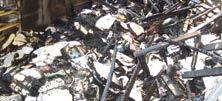
4 minute read
COVID impacts on fire and flood recoveries

By Emma Dadson
Advertisement
Dealing with incidents of fire and water damage to documents is often a major challenge for information managers and archivists at the best of times, but the emergence of COVID in 2020 compounded these challenges. Emergency plans, written pre-pandemic, required rapid revision. With the vast majority of staff responsible for records working remotely, discovering incidents and effective response now relied on skeleton onsite teams with little awareness and training.
The team at Harwell Restoration have still been busy throughout the pandemic. We’ve dealt with damage triggered by flooding, escapes of water, sewage leaks, snowmelt, fires, sprinkler mishaps, ceiling collapses, infestations by rodents and insects, and mould growth. The challenges of COVID have required revision of emergency plans, but will, even as we return to a more normal working pattern, potentially make emergency plans more resilient.
The most obvious pattern we noticed was an increase in water-damaged documents with severe fungal growth and secondary damage over the summer. At Harwell, the substantially lower volume of projects in April and May was reversed by a higher than normal volume of projects in June and July. Delays in discovering water damage will inevitably lead to further deterioration through mould growth, page adhesions and ink migrations. The severe fungal growth suggests these incidents occurred weeks prior to discovery. Although most institutions did instigate checks of storage spaces by security/facilities teams who were on site, their checks were less frequent. Whilst major flooding or a fire is very obvious, escapes of water can be more difficult to spot. A puddle of water on the floor from an escape of water would have time to evaporate, leaving wet boxes on shelves unnoticed. Only when records managers were tentatively allowed back to work was damage spotted – often due to the virulent mould and odour. Such documents are still restorable, but the process more complex and costly, owing to the increase in damage.

During the summer, we held dozens of free Zoom sessions for customers, advocating the inclusion of facilities and security staff, stressing the importance of rapid detection of damage and what to look for. In the long term, a closer working relationship between those responsible for buildings and those responsible for documents will have positive effects – more eyes and ears monitoring for
Mouldy documentation
problems, and a greater understanding of the need for rapid response when incidents do occur.
We have also seen customers experience fluctuating capacity to deal with incidents themselves. Many institutions can cope with a certain amount of damage to documents in house, but retain companies such as Harwell to deal with bigger incidents, where they run out of resource – eg, floor space to spread documents out and people to assist with triage and salvage. Many institutions have found this capacity has varied significantly during different stages of the pandemic. During the lockdowns, a benefit has been greater space, as public areas such as restaurants and reading rooms are freed up. However, as lockdowns eased and building occupancy increased, capacity decreased as any available space was used to boost social distancing.

In the long term, greater sensitivity to capacity to deal with incidents in house, and knowing the tipping point where external help from companies such as Harwell might be needed, is very helpful, as it facilitates rapid and decisive action. It avoids scenarios where individuals plough on, trying to salvage themselves, only realising days later when mould growth is established that the quantity was never realistically manageable. There have been positives and negatives. Recoveries from city centres – a breeze in terms of traffic! On the flip side, it’s far harder to weed out anything not required for restoration, when the key decision-makers can’t all be in the same room with the records in front of them. Dynamic decisionmaking in fires and floods, with or without pandemics, can often be a challenge, but perhaps a long-term positive of this difficult year will be that we’ve all had to adapt. We’ve had to be pragmatic, compromise, deal with the unexpected, keep a sense of humour, focus harder on good communication, stay calm and keep people safe – all of which come in handy in fire and flood situations too.
The Author
Emma Dadson is Key Account Manager for Harwell Restoration, the leading service provider of document restoration in Europe. Emma has been twice named the ‘Business Continuity Consultant of the Year’ at the Business Continuity Awards and is an accredited Disaster Recovery Technician, Specialist Restorer and Honorary Fellow of the BDMA. Her book Emergency Planning and Response for Libraries, Archives and Museums (Facet Publishing) was published in 2012.
<emma.dadson@harwellrestoration. co.uk>



